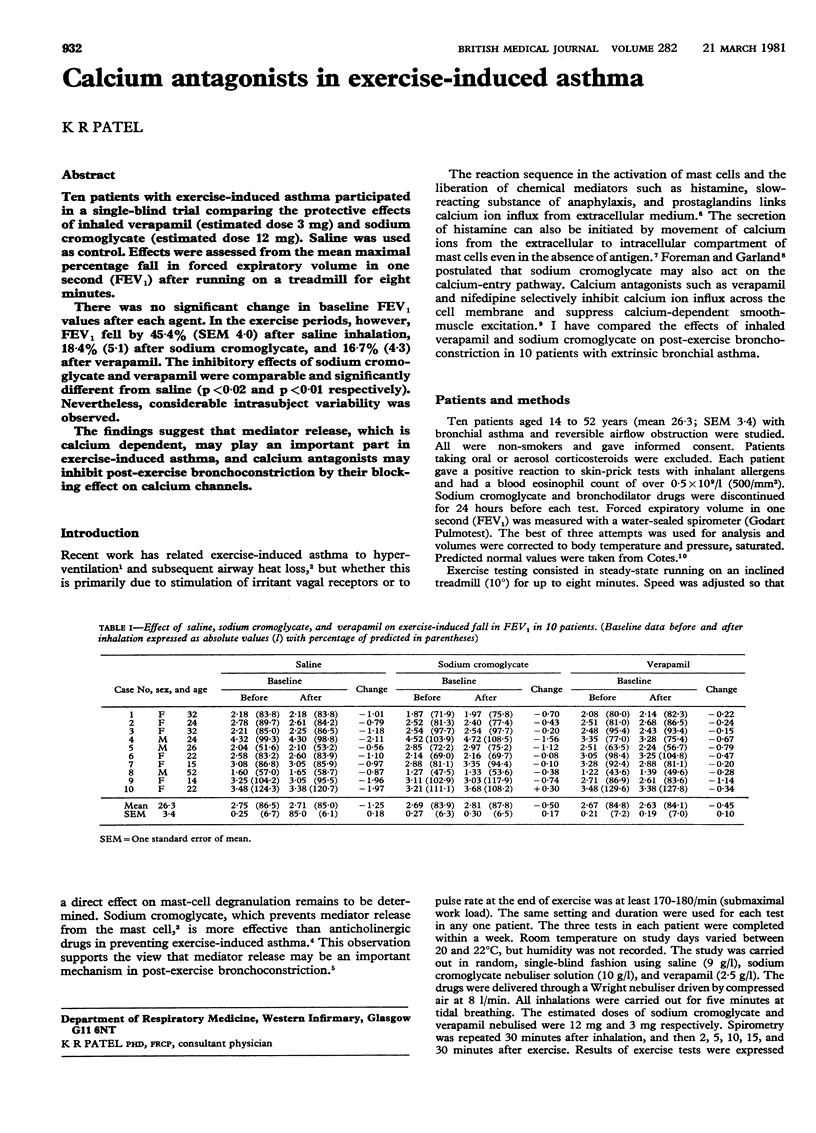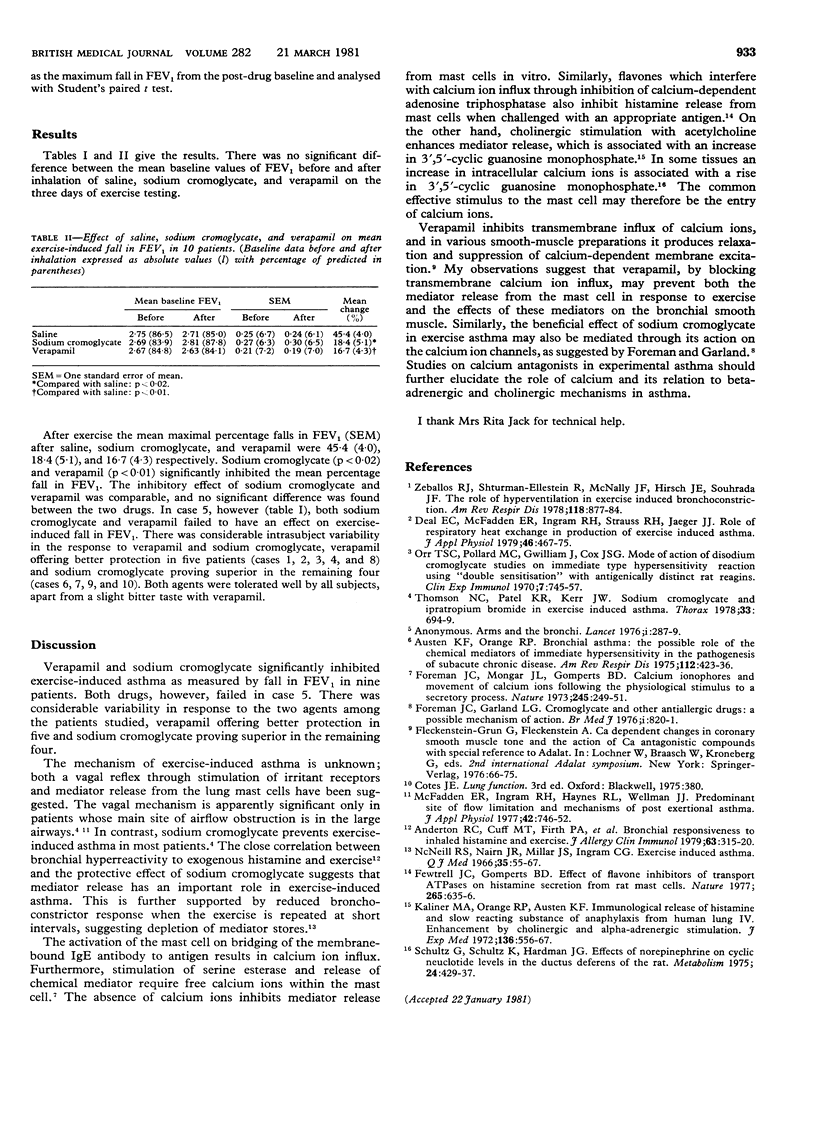Abstract
Ten patients with exercise-induced asthma participated in a single-blind trial comparing the protective effects of inhaled verapamil (estimated dose 3 mg) and sodium cromoglycate (estimated dose 12 mg). Saline was used as control. Effects were assessed from the mean maximal percentage fall in forced expiratory volume in one second (FEV1) after running on a treadmill for eight minutes. There was no significant change in baseline FEV1 values after each agent. In the exercise periods, however, FEV1 fell by 45.4% (SEM 4.0) after saline inhalation, 18.4% (5.1) after sodium cromoglycate, and 16.7% (4.3) after verapamil. The inhibitory effects of sodium cromoglycate and verapamil were comparable and significantly different from saline (p less than 0.02 and p less than 0.01 respectively). Nevertheless, considerable intrasubject variability was observed. The findings suggest that mediator release, which is calcium dependent, may play an important part in exercise-induced asthma, and calcium antagonists may inhibit post-exercise bronchoconstriction by their blocking effect on calcium channels.
Full text
PDF

Selected References
These references are in PubMed. This may not be the complete list of references from this article.
- Anderton R. C., Cuff M. T., Frith P. A., Cockcroft D. W., Morse J. L., Jones N. L., Hargreave F. E. Bronchial responsiveness to inhaled histamine and exercise. J Allergy Clin Immunol. 1979 May;63(5):315–320. doi: 10.1016/0091-6749(79)90125-8. [DOI] [PubMed] [Google Scholar]
- Austen K. F., Orange R. P. Bronchial asthma: the possible role of the chemical mediators of immediate hypersensitivity in the pathogenesis of subacute chronic disease. Am Rev Respir Dis. 1975 Sep;112(3):423–436. doi: 10.1164/arrd.1975.112.3.423. [DOI] [PubMed] [Google Scholar]
- Cox J. S., Orr T. S., Pollard M. C., Gwilliam J. Mode of action of disodium cromoglycate, studies on immediate type hypersensitivity reactions using 'double sensitization' with two antigenically distinct rat reagins. Clin Exp Immunol. 1970 Nov;7(5):745–757. [PMC free article] [PubMed] [Google Scholar]
- Deal E. C., Jr, McFadden E. R., Jr, Ingram R. H., Jr, Strauss R. H., Jaeger J. J. Role of respiratory heat exchange in production of exercise-induced asthma. J Appl Physiol Respir Environ Exerc Physiol. 1979 Mar;46(3):467–475. doi: 10.1152/jappl.1979.46.3.467. [DOI] [PubMed] [Google Scholar]
- Fewtrell C. M., Gomperts B. D. Effect of flavone inhibitors of transport ATPases on histamine secretion from rat mast cells. Nature. 1977 Feb 17;265(5595):635–636. doi: 10.1038/265635a0. [DOI] [PubMed] [Google Scholar]
- Foreman J. C., Garland L. G. Cromoglycate and other antiallergic drugs: a possible mechanism of action. Br Med J. 1976 Apr 3;1(6013):820–821. doi: 10.1136/bmj.1.6013.820. [DOI] [PMC free article] [PubMed] [Google Scholar]
- Foreman J. C., Mongar J. L., Gomperts B. D. Calcium ionophores and movement of calcium ions following the physiological stimulus to a secretory process. Nature. 1973 Oct 5;245(5423):249–251. doi: 10.1038/245249a0. [DOI] [PubMed] [Google Scholar]
- Kaliner M., Orange R. P., Austen K. F. Immunological release of histamine and slow reacting substance of anaphylaxis from human lung. J Exp Med. 1972 Sep 1;136(3):556–567. doi: 10.1084/jem.136.3.556. [DOI] [PMC free article] [PubMed] [Google Scholar]
- McFadden E. R., Jr, Ingram R. H., Jr, Haynes R. L., Wellman J. J. Predominant site of flow limitation and mechanisms of postexertional asthma. J Appl Physiol Respir Environ Exerc Physiol. 1977 May;42(5):746–752. doi: 10.1152/jappl.1977.42.5.746. [DOI] [PubMed] [Google Scholar]
- McNeill R. S., Nairn J. R., Millar J. S., Ingram C. G. Exercise-induced asthma. Q J Med. 1966 Jan;35(137):55–67. [PubMed] [Google Scholar]
- Schultz G., Schultz K., Hardman J. G. Effects of norepinephrine on cyclic nucleotide levels in the ductus deferens of the rat. Metabolism. 1975 Mar;24(3):429–437. doi: 10.1016/0026-0495(75)90122-5. [DOI] [PubMed] [Google Scholar]
- Thomson N. C., Patel K. R., Kerr J. W. Sodium cromoglycate and ipratropium bromide in exercise-induced asthma. Thorax. 1978 Dec;33(6):694–699. doi: 10.1136/thx.33.6.694. [DOI] [PMC free article] [PubMed] [Google Scholar]
- Zeballos R. J., Shturman-Ellstein R., McNally J. F., Jr, Hirsch J. E., Souhrada J. F. The role of hyperventilation in exercise-induced bronchoconstriction. Am Rev Respir Dis. 1978 Nov;118(5):877–884. doi: 10.1164/arrd.1978.118.5.877. [DOI] [PubMed] [Google Scholar]


